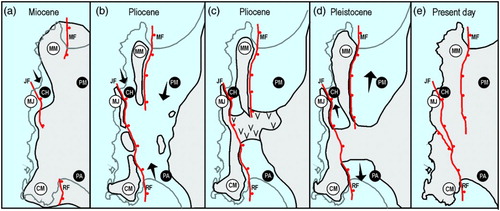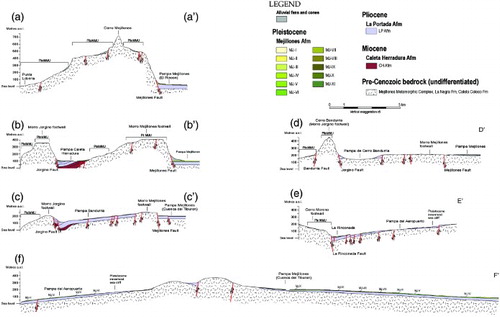Figures & data
Figure 1. Map of the Mejillones Peninsula. (a) Regional tectonic setting after CitationNiemeyer, González, & Martínez-de Los Ríos (1996). (b) Geology adapted from CitationArmijo and Thiele (1990); MMB, Morro Mejillones Block; MF, Mejillones Fault; PM, Pampa Mejillones basin; MJB, Morro Jorgino Block; JF, Jorgino Fault; CH, Caleta Herradura basin; CMB, Cerro Moreno Block; RF, La Rinconada Fault; PA, Pampa del Aeropuerto basin.
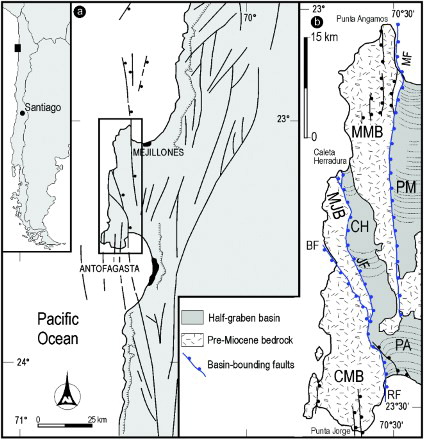
Figure 2. Schematic stratigraphic chart summarising the main miocene to pleistocene allostratigraphic and morphostratigraphic units exposed in the mejillones peninsula.
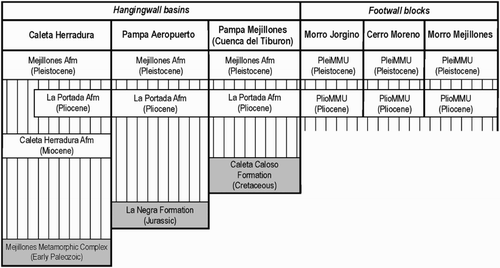
Figure 3. (a) Aerial view over the north-facing Caleta Herradura de Mejillones section where the wedge-shaped, Miocene to Pleistocene clastic infill of the Caleta Herradura half-graben is spectacularly exposed. The basin fill is composed of three major unconformity-bounded units: the Miocene CH Afm, the Pliocene LP Afm and the Pleistocene MJ Afm. The basin is bounded to the west by the listric, steeply dipping Caleta Herradura Fault. In the background, flat surfaces on the crestal and flanking areas of the Morro Jorgino footwall block represent marine terraces of Pliocene and Pleistocene age, respectively. The dotted lines indicate unconformity surfaces. The black box is enlarged in d); (b-c) Exposure of Plio-Pleistocene shallow-marine strata at La Portada, southern end of Pampa del Aeropuerto. Note the highly irregular, non-conformable contact between the Jurassic La Negra Fm and the Pliocene LP Afm in the lower half of (b) and the sharp, erosional contact (dotted black line) of the MJ Afm on top of LP Afm; (d) enlargement of (a) (black box) showing the angular unconformity that separates the CH Afm below from the Pliocene LP Afm above and the strongly asymmetric syncline, possibly induced by normal drag against the fault, in the immediate hangingwall of the Caleta Herradura Fault; (e) road cut photo of the LP Afm and the overlying MJ Afm at Mejillones; (f) photograph showing the contact between the dark coloured pre-Miocene bedrock and the sediments of the LP Afm on the upthrown Morro Mejillones block, about 3 km northwest of Cuenca del Tiburon. The contact (dotted line) is characterised by low mounds that suggest a rugged topography of the substrate.
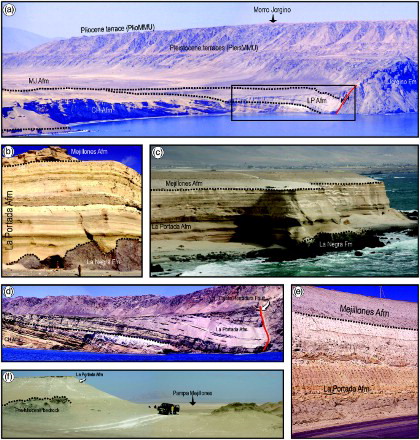
Figure 4. Field photographs showing (a) a series of marine terraces (PleiMMU) carved on the bedrock (white arrows) that pass into extensive sets of beach ridges (Mj Afm, red arrows) in the Caleta Herradura half-graben (in the background, marked by black arrows, the PlioMMU terraces); (b) Pliocene and Pleistocene terraces (black and white arrows, respectively) at Morro Mejillones, northern end of the Mejillones Peninsula. The San Luciano fault is a normal fault that downthrows the rocks to the west (i.e., to the right in the figure); (c) Pleistocene marine terrace (white arrow) partly hidden by alluvial fan deposits shed from the Morro Mejillones footwall block (El Rincon, Mejillones Bay, encircled person for scale in the lower left side); (d) the staircase-morphology formed by the flight of Pleistocene terraces (PleiMMU) at Rada de Abtao (the inner margin of the terraces are highlighted by the dashed black lines). In the background (upper left-hand side) the high palaeo sea-cliff is cut by the Pliocene terraces (PlioMMU) on the top of the Morro Mejillones footwall block (black arrow).

Figure 6. (a) Westward view of the north-south striking Mejillones Fault at Pampa Mejillones, 3 km south of El Rincon. The trace of the fault scarp is marked by black arrows; (b) photograph (above) and line drawing (below) of an outcrop view of the Caleta Herradura de Mejillones section showing two related but distinct systems of extensional faults dissecting the infill of the hangingwall basins: a blind system active during deposition of the CH Afm (yellow) and a surface-breaking system (red) that cut sediments of the CH Afm with large vertical displacements but do not significantly offset sediments of the overlying MJ Afm, revealing that most of the faulting took place after deposition of the CH Afm and prior to deposition of the MJ Afm; (c) outcrop photo of a small-displacement, down-to the west normal fault at La Portada. The base of the Pleistocene MJ Afm (dotted line) is downthrown about 5 m.
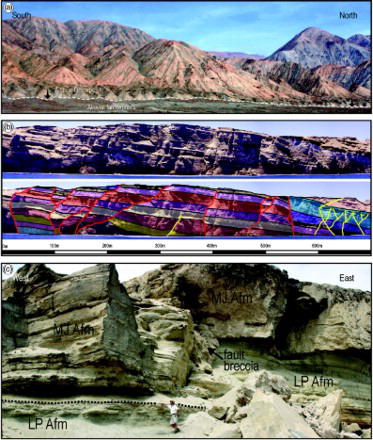
Figure 7. Schematic palaeogeographical maps illustrating the Miocene to Pleistocene history of the Mejillones Peninsula (see text for explanation). MM, Morro Mejillones Block; MF, Mejillones Fault; PM, Pampa Mejillones basin; MJ, Morro Jorgino Block; JF, Jorgino Fault; CH, Caleta Herradura Basin; CM, Cerro Moreno Block; RF, La Rinconada Fault; PA, Pampa del Aeropuerto basin.
